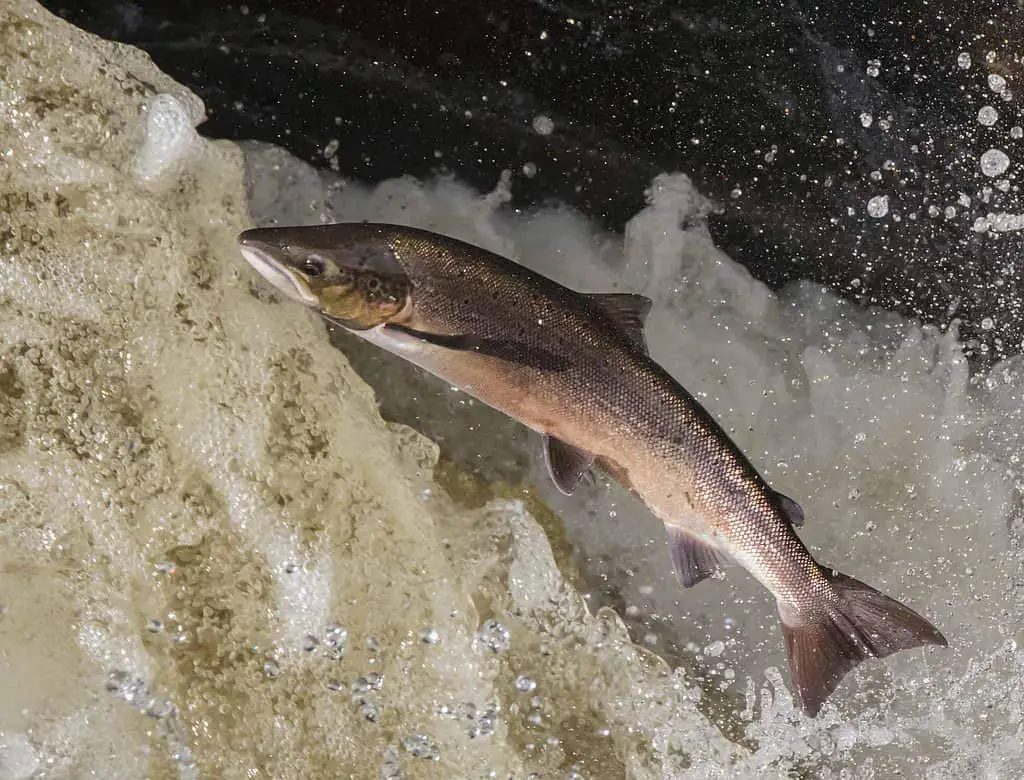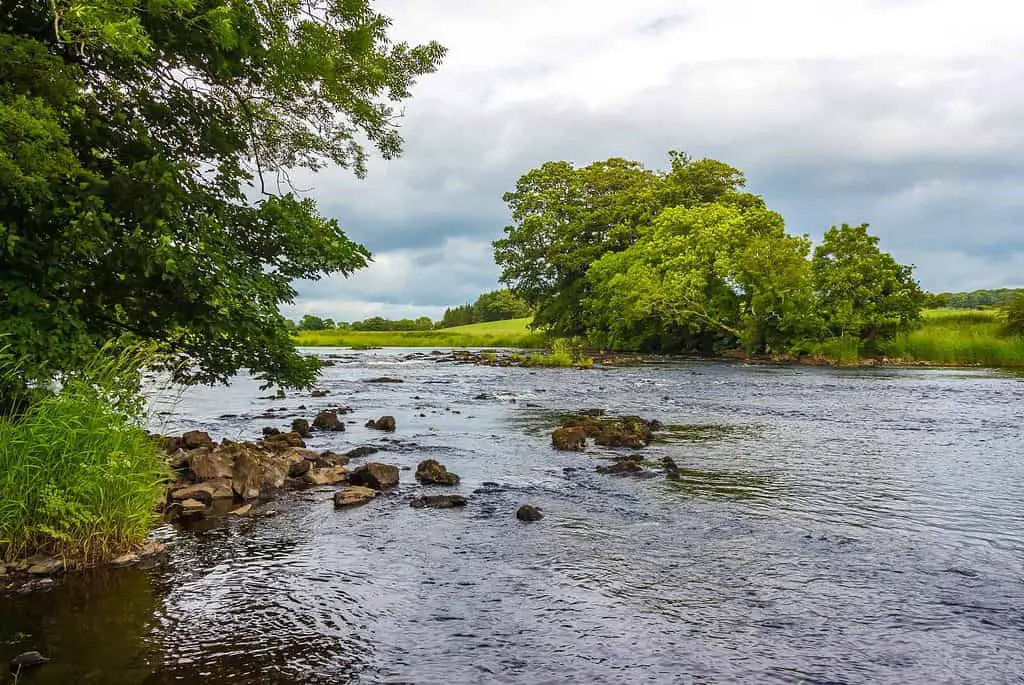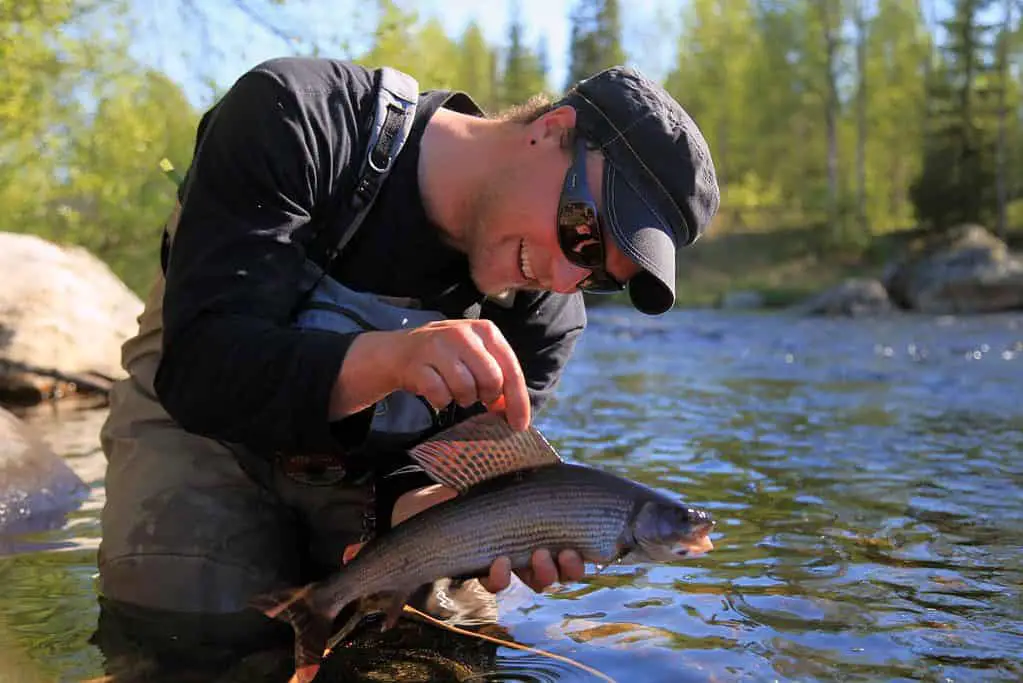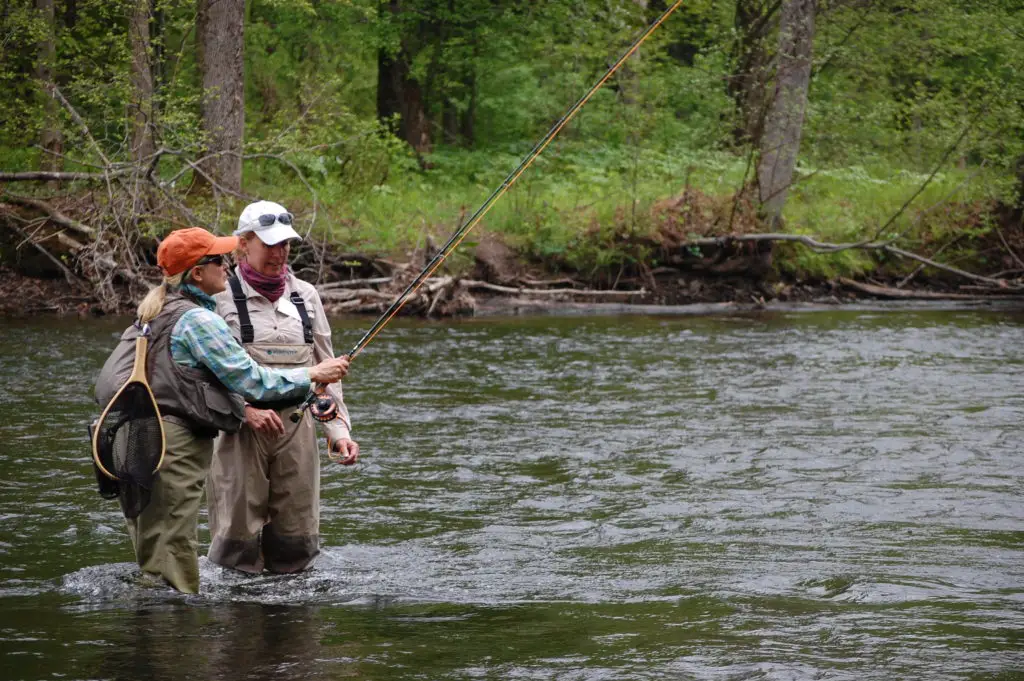Disclosure: Some posts contain affiliate links, which earn us a commission if you make a purchase through them. Positive Fishing © participates in various affiliate networks including the Amazon Services LLC Associates Program.
Scotland is known as the home of fly fishing for Atlantic salmon. While fly fishing for trout and grayling has been common in England since the 13th century, it wasn’t until 1810 that fly fishermen began swinging flies for salmon. Salmon fishing first started on Scotland’s River Tweed.
While salmon fishing is pretty much the heartbeat of fishing in Scotland, this stunning country has much more to offer. Between the highland tarns, huge rivers, small streams, and more lochs than you can count, you’ll find that fishing in Scotland is quite diverse. Plus, you had the added benefit of fishing alongside some of the most beautiful scenery in Europe.
With so many angling opportunities, knowing where and when to go fishing in Scotland is no easy task, and I’m here to help with that.
Having fished in Scotland many times over the last few decades. I’ll guide you to finding the right waters, where to book your fishing, and the best times of year to fish.
Key Takeaways
- Scotland is renowned worldwide for its superb salmon and trout fishing
- Learn where the best rivers and lochs to fish and who to book your fishing trip with
- Get the inside information on where and when to fish, alongside suggested methods,
What Are The Top Fish To Catch In Scotland?

rivers in Perthshire Highlands
Scotland is home to more than just salmon, and there are quite a few different species you can target between all the rivers and lochs.
Here are the top fish to catch in Scotland:
- Salmon
- Sea Trout
- Brown Trout
- Grayling
- Rainbow Trout
- Pike
- Cod
- Haddock
As you can see, salmon is just one of a list of awesome fish species you might find at the end of your line in Scotland. Often called Scottish salmon (as it is caught or farmed in Scotland), it is an Atlantic salmon. The Atlantic salmon is one of seven species found worldwide.
In Scotland’s rivers, typically, you can find four of the five species in a single stretch of water, making for a day of very diverse fishing.
Where To Go Fishing In Scotland?
When it comes to going fishing anywhere in the world, the first step to success is finding a productive place to fish. If you were to do an online search to narrow down fishing spots in Scotland, you would get so many results that you’d be overwhelmed.
In late 2023, Scottish salmon were officially added to the endangered species list due to declining numbers over the past 15 years. This creates an even bigger challenge for anglers fishing for salmon in the country.
Below are my favourite rivers and locations to avoid unproductive waters and fish confidently from your first cast.
Fishing The East Coast Salmon & Sea Trout Rivers

On the east coast of Scotland is where you’ll find the most famous salmon rivers you have most likely heard of. These include the famous four of the Spey, Tweed, Dee, and Tay rivers, but there are many other river options where you can fish.
The River Dee is probably one of the world’s most beautiful and iconic salmon rivers. While the fishing is excellent, the river flows through ancient Scottish estates and past old castles. You couldn’t find yourself in a Scottish salmon fishing setting more than on the Dee!
As I mentioned at the beginning, the River Tweed is the home of salmon fishing and is one of the country’s best salmon and sea trout rivers. The River Tay is the largest salmon river in Scotland, and it is one of the few salmon rivers where spinning for salmon and trout, as well as traditional fly fishing, is permitted.
Tip: The largest Atlantic salmon caught in the UK was a 64lb specimen in 1922! This was caught on the River Tay at Glendelvine
The Spey is also incredibly beautiful and holds some great fishing. Other rivers worth fishing include Don, Teith, Findhorn, North Esk, South Esk, Deveron, and Earn.
If you want to go salmon fishing on the Big Four rivers, you must book well in advance to get a slot, as they are hugely popular, especially during the Autumn run.
Fishing The West Coast Salmon & Sea Trout Rivers
The salmon and sea trout rivers on Scotland’s west coast tend to be much smaller than the east coast rivers. This means they rely heavily on rainfall for salmon and sea trout to run up into their higher reaches, known as Spate rivers.
Tip: A spate river is usually a fast-flowing river fed by heavy rainwater. The water level rises and falls very fast.
Fishing these rivers successfully is all about timing, as the salmon and sea trout will hold in the estuary until enough rain falls before running upstream. Some great west coast rivers to fish include the Stinchar, Morar, Bladnoch, Annan, Nith, Kirkaig, and Awe.
You can learn more about fishing the River Stinchar and its main tributaries in South Ayrshire.
Fishing For Brown Trout & Grayling In Scottish Rivers

All the salmon and sea trout rivers mentioned above also have excellent brown trout and grayling fishing, but some are much better than others. If you want to do a few days of trout and grayling fishing mixed up with some salmon, these are the rivers to focus on.
The River Don is probably the best trout river in Scotland as it holds some superb specimens. Along with the Don, consider the rivers Annan (Dumfriesshire, Southern Scotland), Glass (Cannich, in the Scottish Highlands), Clyde (South Lanarkshire at Thankerton) and Tummel (Perth and Kinross), where both Grayling and trout are abundant and a decent size.
Fishing For Brown Trout In Scottish Lochs
Brown trout are native to Scotland and, therefore, inhabit almost every loch in Scotland, and there are more than 30,000 lochs across the country!
Tip: The largest brown trout caught in the UK was a 31lb 12oz monster from Loch Awe.
The general rule regarding Scottish lochs and brown trout is that the higher the altitude or most northern location of the loch, the smaller and more aggressive the trout are. This is due to fewer insects and less food for the fish, making them smaller but far feistier!
Lochs at lower altitudes have much more insect life and thus produce bigger trout; these are the lochs we will focus on.
Here are the top brown trout lochs in Scotland:
- Loch Arkaig
- Loch Leven
- Loch Assynt
- The lochs of Orkney
- Fairy Lochs
- Shetland and Uist
- Loch Watten
- Loch Shin
- Loch Morar
- Loch Laidon
If catching a huge brown trout in a loch in Scotland is your dream, then you’ll want to focus on the limestone lochs of Scotland. Limestone lochs provide alkaline waters, allowing for an abundance of aquatic food for trout to eat, and thus, they grow to sizes of 10lbs and above.
However, there aren’t many limestone lochs in Scotland; you’ll want to focus your fishing on Cape Wrath lochs and Reay Lochs.
Fishing Rainbow Trout Commercial Waters
Rainbow trout are not native to Scotland but can be found nationwide. “Bows” have been stocked into Lochs (lakes) to create an extra sporting option. Most rainbow trout waters are fished from a boat.
Rainbow trout fishing in Scotland is available all year round, and there is no closed season.
Here are the top rainbow trout lakes and lochs in Scotland:
- Loch Fad
- Loch Frandy
- Coldingham Loch
- Carronvalley reservoir
- Butterstone
- Lake Menteith
There are many commercially stocked rainbow trout waters throughout Scotland. Aberdeenshire and the Central Belt area (near Edinburgh, Glasgow, Stirling) have the largest concentrations. It is widely known that the Menteith and Carronvalley are renowned as the best loch and reservoirs, respectively, that offer excellent fishing for large quantities of large, fierce, fighting “bows”—both locations have a weekly stocking program.
Fishing Scottish Pike Lochs
If you want to do excellent pike fishing in Scotland, you’ll be pleased to hear that some lochs hold giants well over 20lbs.
The general rule regarding pike lochs in Scotland is that the bigger the loch, the bigger the pike. However, where there are pike, the trout fishing isn’t as good in these lochs, as the pike tend to enjoy eating a good size trout!
Here are the top pike fishing lochs in Scotland you should focus on: Loch Rutten, Loch Awe, Loch Ken, Loch Lomond, and Loch Tay.
Sea Fishing In Scotland
Sea fishing locations are abundant from the coast of Scotland. From the Lochs to the open seas, species such as sea trout, salmon, and mackerel can be found in the waters surrounding the Isle of Skye.
Visit Loch Goil if you fancy fishing for cod, whiting, plaice, mackerel, skate, and pollack. Sadly, Loch Long has declined recently due to the heavy trawler fishing.
Head for Cruden Bay, Sandford Bay, and the harbour at Peterhead are popular shore fishing spots for ling, conga, dab, turbot and sea bass.
One of the places close to my heart is the Largs and Wemyss Bay areas. It’s where I first started sea fishing with my father, catching small fish such as dogfish, whiting, cod, gurnards, rockling, flounders and mackerel from the shingle beach at Largs. It’s still popular today at close range, mainly during the summer.
When To Go Fishing In Scotland
The fisheries department regulates fishing in Scotland; therefore, each species’ fishing seasons are well-defined. This protects the fish and ensures they are not under any fishing pressure when they might be vulnerable.
Salmon and sea trout seasons on Scottish rivers vary from river to river. Generally, fishing opens in January or February and runs until September or October.
The choice of which river and the right season to go to can be very complicated. To make this easier, check out the “Scottish Salmon Fishing seasons,” which provides for each river what are the specific opening and closing dates,
Trout fishing in Scotland runs from March through to October, with some rivers, such as the Tay, opening their fishing in April and closing in September.
Grayling fishing seasons also differ from river to river; some are open all year round, and others only open over winter from November to February.
There are no regulations on pike fishing in the lochs, so you can fish all year round. However, the best times are between October and April during the colder winter months.
Best Ways Of Catching Fish In Scotland
Most fishing in Scotland for salmon, sea trout, trout, and grayling is fly fishing only, but this depends on the river or loch you’re fishing in. The River Tay, for example, also allows anglers to use spinning rods to catch salmon, but there aren’t many other places that do.
When fly fishing for salmon on the big rivers of Scotland, you’ll need a double-handed spey rod of 13 to 15ft long to cast the distances required. For most scenarios, anglers should use 8-10 weight fly lines (floating, sink tip or intermediate, and fast sinking line)
In lower water conditions, lighter rods such as a single-handed, 10ft 6in long, 8-9 weight rod are perfect for grilse ( grilse are salmon which have been to sea for one year only, salmon that have been to sea for two years are known as “two-sea winter” then “three-sea winter”) and sea trout fishing. For brown trout, 5-7 weight, 8-10ft single-handed rods are the best choice.
On the smaller rivers, switch (a combination of a single-handed fly rod and a two-handed Spey rod). Which can be cast overhead using one hand or use the bottom handle with your other hand to do roll casts) The less complex single-handed rods are the other option and will perform well.
If you’re pike fishing on the lochs, casting big lures and using dead baits with a spinning rod is the norm, and it’s very effective. Fishing from a boat or the shore both yield pike.
Tip: The use of any live bait is illegal in Scotland.
Another option proving increasingly popular is fly-fishing for pike, where you will experience their immense power as they obliterate your fly. Use big predator flies such as clouser minnows or those that closely resemble the baitfish in the water you fish.
How To Book Your Fishing Trip To Scotland

more hands-on approach to learning fast
You have two choices when booking your fishing trip to Scotland. You can do a DIY fishing trip by hiring a car or booking your spots on the rivers using FishPal.
I love DIY fishing as it’s more of an adventure, but it can lead to being in the wrong places at the wrong time if you don’t understand the area.
Scotland has many options for guided fishing trips. Scotia Fishing provides a first-class experience and with a more personal touch hands-on guide in Scotland. Besides salmon and trout, they offer pike, grayling and sea pollock fishing.
They also offer fly fishing casting tuition and a whiskey and fishing experience, which is a very unique and pleasurable experience. I highly recommend choosing to go with the team from Scotia Fishing, and I can assure you it will be a valuable and memorable fishing experience.
If you want more of a guide experience and need someone to manage accommodation and transport, you should talk to either Aardvark McLeod or River & Green. Both are large, reliable companies that can deal with any unique requests that you may have.
I recommend the self-catering Kerrow House for trout and salmon fishing on the River Glass at Glen Affric if you want a more “homely” touch.
Finally, getting to know the locals in the pub or visiting the tackle shops can help considerably in finding those lesser-known spots. While anglers can be rather secretive, with some friendly chitchat, most will give you some pointers on methods and specific pools to try. It’s worth buying the locals a dram of whiskey to discover their vast local knowledge!
Fishing Regulations In Scotland
Buying a licence to fish with rod and line anywhere in Scotland (apart from the Border Esk region) is not required. However, where the Border Esk flows into England, you must buy a rod fishing licence for England and Wales to fish any part of it. This includes the parts of the river and the tributaries in Scotland.
More important to note is that you must book and pay for the beat or area you’re fishing on through permission from the landowner or an angling club. Many stretches of river are privately owned and require prior permission or a membership to fish them. If you book with either of the fishing companies mentioned above, they will have already arranged the license for you. If you’re doing DIY, then FishPal is the way to go.
Tip: Fishing for salmon and sea trout on a Sunday is strictly prohibited. Fishing for brown trout on Sundays is legal but is somewhat frowned upon on some rivers.
Haste Ye Back!
Thanks for reading my article; I hope you enjoyed it and are ready to go fishing in Scotland. It’s one of the world’s most beautiful places to go fishing, especially if you love fly fishing.
If you’re planning a UK fishing trip, please read my related articles on freshwater fishing in England or my beach and boat fishing best locations in England if you are more of a saltwater angler.
- Top Tips For Fishing With Feathers - January 15, 2025
- How To Fish For Flounders: Tips, Rigs, & Baits - March 27, 2024
- Fortis Wraps Fishing Sunglasses: The Affordable Option For Anglers - January 25, 2024

